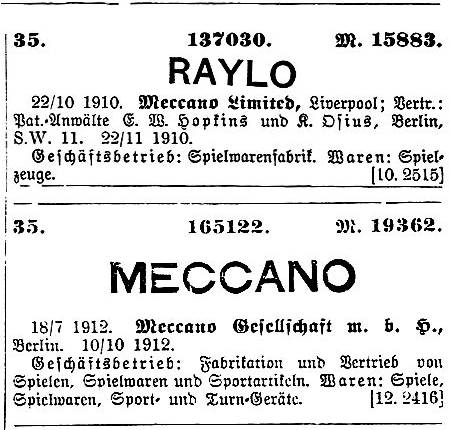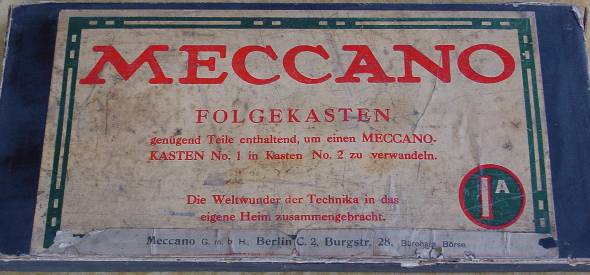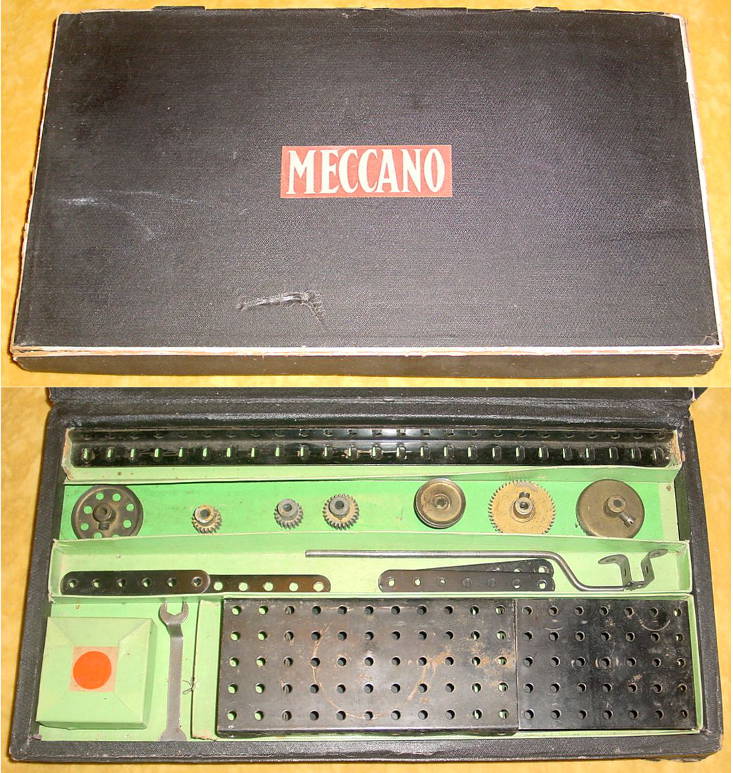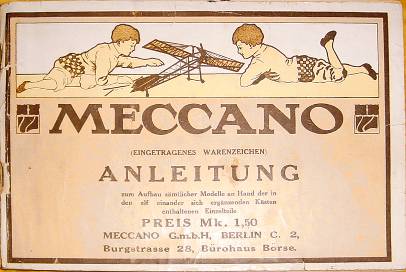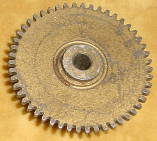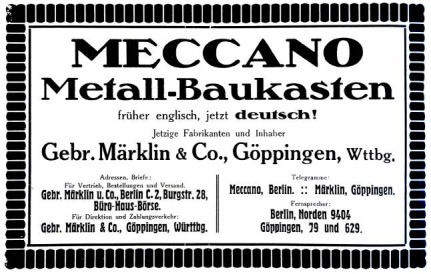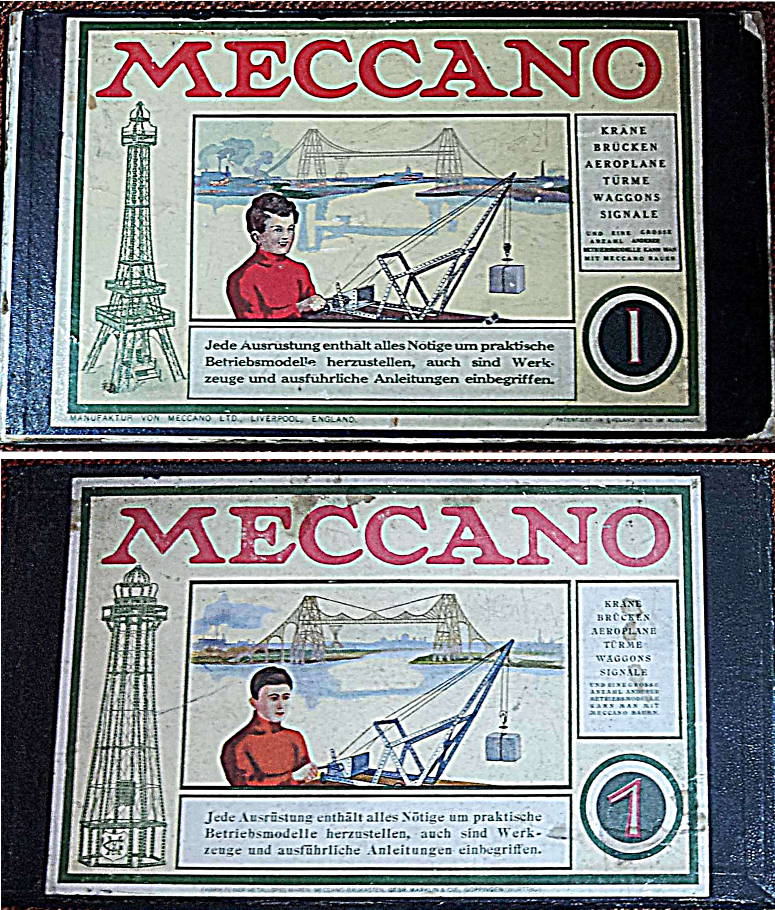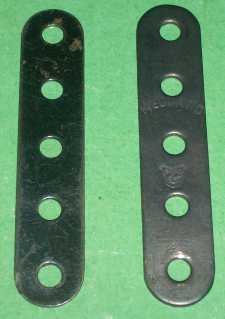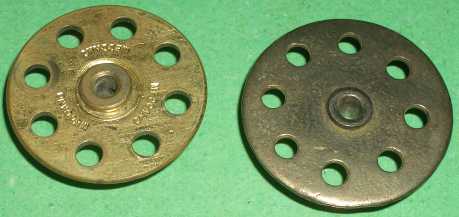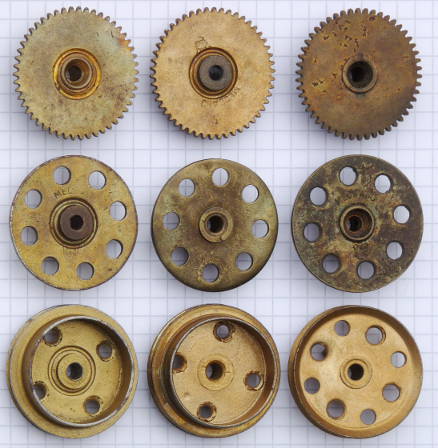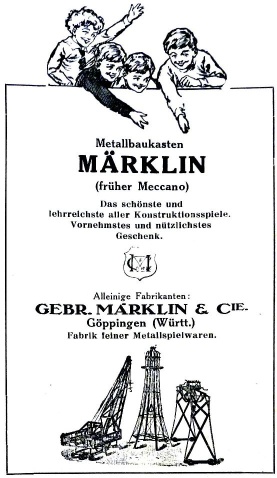From Hornby's Meccano in Germany to the First Sets of the Metallbaukasten Märklin
Inhaltsverzeichnis
Summary
In 1908, the English metal construction set Meccano appeared on the German
market. In 1912 a German Meccano subsidiary for trading was established in
Berlin.
With the begin of World War I in August 1914 this German Meccano office,
was considered enemy's property and therefore subdued to compulsory German
administration. On 15th August 1917 the Märklin company acquired the stocks,
protective rights and Meccano trademark from the German Reich
government.[1]
Märklin sold the Meccano sets until June 1919 still under the name
Meccano.[2] Then, from 25th June 1919 onward, they only used
the name Metallbaukasten Märklin.[3]
But how did this happen in detail? What connections existed between
Meccano and Märklin in this period from 1908 to 1919?
There are several trustworthy historical sources about the cooperation between
Meccano and Märklin in the time from 1910 to 1914. And there are secure sources
from 1917 to 1919 documenting the evolution in Germany from Märklin's Meccano
sets to the Metallbaukasten Märklin in 1919.
I would like to show the facts here, which are proven by these secure
sources.
But I would also like to highlight, however, those popular assumptions about
Märklin, which are cited in some publications even as a historical reference,
and so treated like facts, which they are not.
As can be proven there was a sales cooperation between Meccano and Märklin in
1911. Then there were deliveries of Märklin clockwork motors to
Meccano in England between 1910 and 1914.
And Märklin was a component supplier of some few parts, e.g. gear wheels, for
the German Meccano subsidiary in Berlin.
Of course Meccano in England was producing these parts
in parallel.
All Meccano outfits sold in Germany so far, were put together in England using
parts produced there. The German manual was
also printed in England.
In the times of World War I (from August 1914), however, there was
definitively no business relationship or even cooperation between Märklin
and Meccano in England.
There was a collaboration between Märklin and the German Meccano subsidiary
under compulsory German administration in the period from September 1914 to
July 1917. Märklin supplied gear wheels, probably also some other wheels.
In some publications about Märklin there was written, that the Metallbaukasten
Märklin has existed already in 1914. In others 1915 or 1916 is assumed as
begin. This statement is highly questionable.
The Metallbaukasten Märklin existed - historically approved - only from June
1919 onward on the market.[3]
With their early years also others are playing around a bit. There was written,
that Hornby had his ideas for Meccano already before 1901,
and dates from the end-1890s were presented for the invention of the
metal construction set.[4]
Historical documents for this, however, are missing.
I have to refer here to the Forum 1914 Marklin Meccano
outfits[5] at www.nzmeccano.com, where the development was
discussed on the basis of sets found.
I have taken many ideas from the forum posts.
In the following only the time till about 1922 is covered. For details about
the later Märklin sets I recommend Markus Schild's
website.
Hornby's Meccano in Germany until August 1914
In January 1901 the Englishman Frank Hornby applied for
an English patent[6] on a metal construction set.
In November 1901 he was granted the patent.
Soon Hornby could get patents for his metal construction set also outside
England. However, in countries where the newsworthiness of inventions
was reviewed by the Patent Office, he was having trouble.
So in the USA only his fastening method for the wheels on the axles with
spring clips was accepted as a patent.[7]
In Germany, he did not even try to get a patent -
his invention would largely not have been patentable.
We can really assume that Hornby invented his Meccano completely alone.
But in terms of patents the temporal order of applications is important,
including the order of the inventions of components.
The person, who invented a component first, got the patent for it.
So Gustav Lilienthal is the inventor of equidistantly perforated
flat strips. In 1888 he already applied for a
patent[8] for his invention in the name of his brother
Otto.[9]
A person, who - like Hornby - invented the equidistantly perforated
strips later again, did not have a chance.
In the first time Hornby sold his sets under the brand name Mechanics
Made Easy. In 1907 he used the name Meccano.
His former employer David Hugh Elliott, a cattle salesman, borrowed Hornby,
his cashier, money, and helped him to establish the company.
In 1908 Hornby's company, now named "Meccano Ltd",
was self-sufficient, and Elliott left the
company.[10]
Hornby's Meccano grew rapidly. The parts and models were
continuously improved and their number increased.
His flat strips were nickel finished in 1911, rounded and had a hole spacing
of half an inch or 12.7mm. The flat strips were joined by
screws and square shaped nuts of the 5/32" BSW thread.
As axles he used pieces of thick wire (8-gauge wire, corresponding to
4.06-4.1mm wire diameter) with a narrow longitudinal slot.
These axes could only rotate in a model and they had to be secured
by clips from falling out.
The wheels also had a longitudinal slot in the hubs. They had to be
fixed on the axles by means of special spring clips. A tongue in the clip
engaged in the slot of the longitudinal axle and in the slot of the wheel.
However, this type of attachment was not very rigid.
Hornby's Meccano quickly spread throughout Europe.
Already around the year 1908 a manual was issued in German language.
The established manufacturers of construction sets in Germany could not oversee
this. Franz Walther, who had achieved an excellent reputation for his metal
construction set and also for his wooden sets since 1904, saw a
challenge here.
Therefore in 1911 he launched a new metal construction set, which looked
like Meccano in some aspects.
Franz Walther only had to make some modifications in his older metal
construction set from 1904, namely Walther's Ingenieur Bauspiel.
He made the the strips with a larger hole spacing, and he fixed the parts
together with screws and nuts (instead of clips).
Unlike Meccano he used threaded rods as axles in his metal construction
set "Ingenieur Bauspiel" (engineer building game) since 1904. This was a real
technical advantage compared to the spring clips of Meccano at that
time.[11]
In June 1911 he applied for a registered design (Gebrauchsmuster No. 473 572)
for the method to fasten wheels with nuts on threaded shafts and for using
threaded shafts as connection rods and as traction rods in his metal
construction sets.
Franz Walther called his new metal construction set Stabil
(stable, rigid). These sets were quickly so well known, that the name
Stabilbaukasten became a group term for all metal construction sets
in Germany.
Franz Walther's application for a registered design in June 1911
was perhaps just a reaction to Hornby's application of a registered
design in Germany.
In February 1911 Hornby had applied for his first registered design in Germany
for a "Konstruktionsplatte für Bauspielzeuge" (Gebrauchsmuster No. 455056,
455057), signed in his own name.
Before this application Hornby neither had a patent nor a registered design in
Germany.[12]
Besides that he had only applied for a trademark RAYLO for Meccano Limited
Liverpool on 20th October 1910 in Germany.[13] A find of a
RAYLO metal construction set would be highly interesting.
In 1910/11 there was a first cooperation of Meccano with the German
company Märklin. Beginning end of 1910 Märklin delivered clockwork motors for
Meccano.[14]
Cardboard box and leaflet, however, were produced in England.
These deliveries occurred until the beginning of World War I.
In 1910 Hornby had ended the cooperation with his general sales representative
for Europe, the Weimar company in Rotterdam. The Märklin company
took their place. Therefore the Meccano construction sets were offered
in the French Märklin catalogue of 1911[15].
But in mid-1912 Hornby established his own Meccano subsidiaries in Paris and
Berlin, which took over the sales of Meccano products.
In 1912 Hornby also transferred his German registered designs (Gebrauchsmuster)
and trademark RAYLO to the new Meccano subsidiary in Berlin.
The trademark Meccano was applied for and registered for the new subsidiary on
18th July 1912 and was accepted on 10th October 1912.[16]
Apparently both companies, Märklin and Meccano, were not interested in a public
notification of their cooperation in Germany.
Anyway, I do not know any publication, issued by one of
the two companies between 1912 and July 1917, which show both names,
Märklin and Meccano, in a context.
The German subsidiary of the British company Meccano Ltd., established in
mid-1912, was a trading office in Berlin C2, Burgstr. 28. The building
was called "Bürohaus Börse" and was next to the Berlin Stock Exchange.
There was no production there. But we should assume extensive stocks for
sets and spare parts at some place in Berlin.
The primary task of the subsidiary was the sales of Meccano outfits.
For this purpose the subsidiary has printed publicity material and advertising
brochures of various type in Berlin. These were given to people
showing interest.
The sets, however, were imported directly from England - with German manual and
with a German label on the lid.
The manuals always show the Berlin address. They were printed in England,
which is evident from the logo of the print shop.
On the labels on the lid, however, "MECCANO LTD., LIVERPOOL" is always named
as the producer.
All known Meccano sets of 1914 for the German market were still imported from
England.
The flat strips of Meccano from the period around 1910 were nickel finished.
Beginning in about 1912 also black flat strips were produced in England,
in parallel. These strips were to be used for Germany and Switzerland,
partially also for the Netherlands, Scandinavia and for
France.[17]
A company presentation of Meccano in a German newspaper from 1914 stated
"oxidized" steel as material.[18]
The flat strips were copper plated and then oxidized. The angle brackets
were blackened otherwise.[19]
So there were several technical methods for blackening Meccano parts.
In England, the flat strips remained mostly nickel finished.
But there were exceptions.
The "Inventor's Accessory Outfits" from Meccano contained almost only black
parts. This set was issued at the end of 1915 at the earliest - at a time where
no export from Germany to England was possible because of the First World War
(from August 1914).
Furthermore, from Switzerland sets with black parts are known with
manuals in German language. The sets were delivered in the time form 1914 to
1916 (within the time of WW I) from England to Switzerland. At the end of 1916
production of black parts was abandoned again in England.
It is not known, why black flat strips were produced at all.
Did Meccano want to differentiate their sets from Walther's Stabil sets,
which contained nickel finished parts?
Meccano in Germany from August 1914 to July 1917
With the beginning of World War I, in early August 1914, any monetary
transactions and any trade between the warring countries was
prohibited on all sides.[20]
Patents, licenses or trademarks which belonged to an organization or person
of an enemy state could be deleted or
disabled.[21]
Foreigners could not leave Germany any more. They were "interned",
i.e. they were transferred to an internment camp, which they were not allowed
to leave. In the times of WW I the camp "Ruhleben" was significant. It was in
Berlin-Spandau, near the terrain of a horse racing track.
Hornby, who was visiting Germany in mid 1914, could just leave Germany at end
of July.[22]
The office manager of the Meccano subsidiary, James Paul Porteus, stayed in
Germany, and therefore he was interned in Ruhleben. It is not clear, when
it happened - perhaps even in September,[23] but probably
only in December 1914.[20]
He was allowed to leave Germany 12 months later - allegedly as an invalid as
Meccano Magazine reported.[20]
But in 1917 and later, Porteus was leading the Meccano office in
New York.[24] He did not look like an invalid then.
In November a new regulation of German government was issued in November 1914
stating that French companies could be subdued to compulsory administration in
Germany and in its occupied territories as a revenge.[25]
At end of December 1914 the regulation was extended also to British
companies.[26]
At first this was only an optional regulation. But it already ruled all
details.
In case of a compulsory administation German government appointed an
administrator, who had to put himself into possession of the company.
He was authorized to perform any legal act concerning the company.
He could continue business totally or partially. He was also free to only
finishing the current business operations.
In the time of compulsory administration the powers of the owner of the
company rested, also the authorization of others, to act legally for the
company.
This was common practice at those times. German companies (for example,
Krupp) suffered the same fate in England.[27]
Finally in February 1915 the German subsidiary of Meccano was subdued to
compulsory administration. According to German understanding, the company was
no longer an enemy enterprise then. At Meccano in Liverpool, however,
they called it appropriation.[23]
The exchange broker Martin Hirschfeldt was appointed administrator of the
German Meccano subsidiary by the German government.[28]
For a toy manufacturer, the Christmas season is beginning in as early as
September, when the orders of the toy retailers roll in.
For the 1914 Christmas season in Germany only those Meccano outfits were
available, which had already been on stock before August 1914 in Germany.
The urgently needed imports from England in the pre-Christmas period were
no longer possible.
There will always be a question, if and to what extent manager Porteus or
his German deputy have thought about manufacturing Meccano sets in Germany
after August 1914 in their own responsibility.
No such sets were found yet.
I am sure, Horny would not have agreed to that.
For Martin Hirschfeldt Hornbys business policy should have been irrelevant,
however. He has not taken his job easy in 1915 and later.
He has not only sold off sets, which were on stock.
He also gave order to produce Meccano construction sets from 1915 on.
Many new sets, specially small accessory sets, had to be assembled to
meet the demand for Christmas.
This had to be done in Germany, as an import from England was impossible.
Such sets have been found now.
From Henk Brouwer's (†) former collection a bundle of sets is known,
consisting of a Meccano set no. 1, a no. 1a and a no. 2a.
As the sets were purchased together as a lot, we can assume that the sets
were produced chronologically one after the other.[29]
Henk has allowed to present the pictures, he took of his sets, in a
revised form. Thank you.
The set no. 1 is not shown here. It has a German label, was imported from
England and it still contains the usual Meccano parts from 1913.
The lid label of a contemporary set follows below.
The set no. 1a, an accessory set (Folgekasten), with German label
and original English parts, shows a special feature on the lid.
The reference to the manufacturer "MECCANO LTD., LIVERPOOL" was pasted
over with a strip of paper, now showing
"Meccano G.m.b.H., Berlin C. 2, Burgstr. 28, Bürohaus Börse"
as the address.
Obviously this set no. 1a was from stock, and it was sold by the German Meccano
office after the begin of the war.
England was no longer addressable. So a customer had to approach the German
Meccano G.m.b.H. in Berlin, if he wanted to have
contact.
The third set in Henk's lot is a set no. 2a.
It is a special type of sets. It was made in Germany in 1915 or later,
but before July 1917.
On the box lid there is a rectangular sticker attached with the word "MECCANO"
(white text on red background).
In most other finds of such sets an additional round sticker with the
set number is glued on.
The lid tells nothing about the origin of the set. Only the manual shows the
address of the manufacturer. It was printed in Germany.
No text on the box, no text in the manual and no part is showing any
reference to Märklin or any other metalworking
company.
This is quite obviously a set of the German Meccano G.m.b.H. under
Martin Hirschfeldt.
All parts of the sets were either from existing peacetime stock or
the parts had been manufactured as new parts by local workshops
in Germany.
As the Meccano parts have already been sold as spares in toy shops before the
war, there was a lot of parts in stocks already.
The most common parts in the sets, however, had to be remade soon.
Due to the war restrictions copper and brass were not permitted as material.
Most of the flat strips and particularly the plates from this period are painted
black. The wheels are made from steel, and they were painted bronze.
The parts show no stamping of the name MECCANO or the Märklin logo.
It is not known, which companies or workshops have made these new Meccano parts.
There were many companies that possessed the appropriate knowledge
and could therefore have been involved.
The new manuals, for example, were printed by Bogdan Gisevius in Berlin.
(In 1917 he printed for Märklin, too.)
Special attention deserve the gears and pinions. They were milled from a
"substitute material" (zinc or aluminium). They are very similar in appearance
to former Meccano parts of 1913 and some later Märklin parts of 1917.
The hub mounting of the 50-teeth gear number 27 was performed according to a
processing patented in England.[30]
In this process a circular groove was pressed in the toothed disc, around the
hub. So the material of the disc is squeezed against the hub.
The manufacturing effort and expenses for this process was probably only
invested by a workshop, which had already been a supplier for Meccano before
August 1914.
In Germany at first Märklin is assumed to be such a supplier.
Another indication of a participation of Märklin are finds of clockwork motors,
from which it can be assumed that Märklin had delivered them to Berlin
in times mentioned.
The sets made under supervision of Martin Hirschfeldt are quite rare.
The demand from toys dealers would have been low. In that heated-up
war-time spirit, which German customer wanted to buy a toy, which came from
the land of the enemy? So people preferred to buy the German metal construction
set Stabil.
The Acquisition of Meccano by Märklin
In 1st August 1916 a new regulation of German government came into force.
According to this regulation British companies could be liquidated now.
Subsidiaries, assets and land owned by these companies were also affected.
A liquidator was appointed, who had to put himself into possession
of the company, and then he had to sell the company with all the
assets.[31]
Soon the liquidation of the German Meccano subsidiary was going to be
performed.
On 15th August 1917 Märklin officially acquired the stocks and rights and
the Meccano brand protection from the German Reich government and integrated the
range into their own existing since 1914. ...
On 16th February 1918 Märklin had registered the trademark "Meccano" in the
role of the Imperial Patent Office. ...
So it is written in the Märklin documentation "Die Geschichte des
Märklin-Metallbaukastens"[1] (Geschichte=History).
However, the words "and integrated the range into their own, existing since
1914" are highly questionable.
Before 1917 Märklin never sold a metal construction set of their own
production or offered them in their catalogues or advertisements.
Also no Märklin sets have been found from this period.
The article by Fitting however proves that Märklin acquired the trademark
"Meccano" legally in Germany. It was on 16th February 1918, not earlier.
The acquisition of the German Meccano subsidiary is also reported in the
"Deutsche Spielwarenzeitung" (German Toys newspaper) from 20th September 1917:
The English enterprise Meccano Gesellschaft m.b.H. Berlin, liquidated
by the German Reich, was bought by the well-known Metal Toys Factory Märklin
and Cie. in Göppingen.
The sales and distribution of Meccano metal construction sets will be continued
by the new owner Gebr. Märklin and Cie., Göppingen, Department Meccano,
Berlin, still in the previous office in Berlin, Bürohaus-Börse, Burgstr. 28.
All correspondence should be sent there. The fabrication
will be enhanced for the Christmas season coming, that the orders already
placed and, if possible, those granted to mid-September,
will still be in time for delivery. The business of the
company Gebr. Märklin and Cie., Göppingen, for metal toys will not change
due to this fusion.[32]
The acquisition of the Meccano subsidiary by Märklin was a long-term
strategic decision. The sales figures of the new sets may not have
been great. In the later war years,
the people were suffering. The fathers were at the front or
already dead, the mothers were working in the arms industry or taking over the
work of the men. The grandparents were standing in the enormously long queues
at the grocery shops, for getting something to eat at least.
In 1917/18 many people in Germany were hungry.
From 20th September 1917 to 24th April 1919 ads (see on the right) were
published with the title "Meccano metal construction sets formerly English now
German!"[33]
The Märklin company is mentioned as manufacturer.
The trading office of the Meccano subsidiary in Berlin was closed
by Märklin in 1918. Märklin (or Meccano) could no longer be found in the Berlin
address book of 1919.
The tasks of the Berlin office were now done in Göppingen.
As a consequence, the Berlin address could no longer be found on the
manuals.
So if you can find the Berlin address on the manual of a Meccano set,
together with the name "Märklin", this set should be assigned to the year 1917.
If, however, you only find the Göppingen address on the manual, the set fits
the years 1918/1919.
With the takeover by Märklin, the outer appearance of the sets was
re-established. They were looking like the customers knew them from 1914.
For the lid label the colourful design of 1914 with the large title
"MECCANO" was reprinted in a slightly different form.
Märklin in Göppingen is always mentioned as the manufacturer.
Bengt Johansson has given me the photo for publication. Thank you.
On the new Märklin set (in the picture on the bottom) the Eiffel Tower on the
left side of the label is replaced by a variant of the Meccano tower of 1912,
which shows the contemporary Märklin logo (a coat of arms with the letters
M and G on each other) in the base.
At the bottom of the lid label of the original German Meccano set from 1913
you can read
"MANUFAKTUR VON MECCANO LTD., LIVERPOOL, England.
PATENTIERT IN ENGLAND UND IM AUSLANDE.";
in 1914 this was changed to
"ALLEINFABRIKATION VON: MECCANO Ltd., LIVERPOOL, Engl.
Patentiert in der ganzen Welt."
At the bottom of the lid label of the basic sets made by Märklin you can read
"FABRIK FEINER METALLSPIELWAREN, MECCANO-BAUKASTEN, GEBR. MÄRKLIN & CIE.,
GÖPPINGEN (WÜRTTBG.)".
On the "Folgekästen" (accessory outfits) it reads
"ALLEINIGE SCHUTZRECHTE IN DEUTSCHLAND, FÜR MECCANO GEBR. MÄRKLIN & CIE.,
GÖPPINGEN (WTTBG.)"
The bottom lid label was used by Märklin until 1919.
Based on the findings and on the basis of publications in the contemporary press
we can say with certainty:
Each Meccano set, which shows the name "Märklin" somewhere, was
manufactured by Märklin and is to be sorted to the years 1917 to 1919.
When the Meccano-Märklin sets were filled with parts, first the remaining parts
from earlier times were used up.
It can be assumed that Märklin did not produce all parts themselves
and gave orders to other firms - at least in the early days.
As some of the sets found contain single parts in peacetime quality,
it can be seen that much stock from peacetime was still available to
fill the sets. Then there were still the parts Martin Hirschfeldt had ordered.
Märklin, however, started to manufacture more and more parts themselves.
Bengt Johansson has sent a picture of part 5 from his two sets shown above.
Thank you.
The picture is showing on its left side a part 5 (5 hole strip) from his
Meccano set produced 1913 in England. The part has no stamp
and is rather worn. (Not always the Meccano parts were stamped.)
On the right side in the picture a part 5 of Bengt's set from Märklin
is shown. The name "MECCANO" and the Märklin logo are stamped in.
These parts have a bluish tinge and are not purely black. During production the
parts were - still glowing - quenched in hot oil.
Meccano in England did not apply this method for blackening of metal.
Probably the part shown is one of the first that Märklin have
made themselves.
Several faults can be found on Flat Strips of that time. There are
punching faults, incorrect roundings, defective surface treatments.
Märklin still had to find an optimal way of production.
The plates no. 52-54 were still painted black in 1917. In 1918 the new method
of surface treatment was applied.
The picture on the right (also from Bengt Johansson) is showing Bush Wheels,
part 24. The left example is from the set produced in England in 1913.
It is made of brass and it is stamped.
The right part was in the Meccano set produced by Märklin.
It is not made from brass. Whether the part was manufactured by Märklin, or
whether it is from Martin Hirschfeldt's stock, could not be determined.
Probably it is from Hirschfeldt's stock.
Norbert Klimmek has shown me different Märklin wheels from 1917 and later.
(See right.) You can see a wide variety of hubs.
Märklin had still to learn, which hub fixing method might be optimal.
Some hub fixings were made according to a method patented 1911 in
England.[30] A circular groove was pressed into the
wheel disk, and so the brass of the disk was squeezed against the hub.
The manufacturing effort and expenses for this process were high. So this
method was probably only used by a workshop, which was already a supplier for
Meccano before August 1914. Now we have the evidence that Märklin was a
suppliers for Meccano in those times.
As only some of these parts have such hubs, we can assume that at
Märklin only one press was equipped with the required form.
So in 1917 additional methods had to be employed for hub fixing
to cover the need for wheels. This demand, however, was not extraordinarily
high in that wartime.
This in turn implies that the amount of Meccano parts supplied before August
1914 must have been low.
It is not known, which parts were delivered from Märklin before August 1914.
Obviously gears were among them. For the other wheels (wheels disks,
flanged wheels) there is not enough evidence.
There is no document for such deliveries.
Some of the parts shown in the picture above have a stamp with the name
"MECCANO" and the Märklin logo. The embossing was performed before
the fixing of the hub - the stamping was done on the disc and then the circular
groove was pressed over the Märklin logo.
After the end of the war, at the end of 1918, parts were allowed to be made
from brass again. This might be a help for dating them.
The stamping with the name "MECCANO" and the Märklin logo gradually ceased.
In 1919 it was ended.
Even before World War I Märklin had delivered clockwork motors for
Meccano in England. In 1917 remaining stocks of motors and of components for
them were still present in the Märklin factories at Göppingen.
The remaining side plates of the motors had a hexagonal stamping
"MECCANO LTD LIVERPOOL ENG". This stamping has been punched out of the
side plates until 1919 at the latest. Later many users could not explain the
reason for the resulting opening.[34]
Norbert Klimmek has restored some lots of German Meccano sets from the
period 1913-1918. He has documented his experiences with a lot of pictures
in the internet.[35].
The Metallbaukasten Märklin
From 25th June 1919 at the latest the advertisements in papers for toy trading
only mention the Metallbaukasten Märklin, sometimes even with the
addition "früher Meccano" (formerly Meccano).[3]
The last known ad with Meccano in the title appeared in
11th June 1919.[2]
Märklin explained the change with excellent innovations and
supplements and a much larger and richer
equipment.
As a consequence of the Versailles Treaty, Märklin was prohibited to
use the brand name "Meccano", because now "Meccano" was a product of an English
company again.[36]
Also the lid label of the sets was changed now.
From 1919 it was showing the boy with the crane, which was stuck to the
Metallbaukasten Märklin sets until 1942.
The range of parts of the new Metallbaukasten Märklin initially corresponded
to that of Meccano in 1914. The Meccano parts until number 65 were adopted into
the new system. Part 65, the Centre Fork or the Lathe Trident (Drehbank-Dreizack
in Märklin terms) was soon abandoned.
Märklin also copied the existing Meccano models from 1913, but quickly
developed further new own models. Probably even at the end of 1919, at the
latest in 1920, the sets included some newly developed parts that previously
did not exist in Meccano sets in this form before.
At the beginning of 1919 the Märklin price lists[37] listed the
"Kleine Runde Platte" ("Small Round Plate", Part 67, later 10365).
The "Große Runde Platte" ("Big Round Plate", Part 66, later 10395), also
emerging in early 1919, had only a cord groove in the tread and no holes were
there yet.
Both "Runde Platten" remind me of the bottom of a grenade in their appearance.
There had been assumptions whether moulds for the production of war material
were reused for the production of metal construction set parts.
The "Große Ring" ("Big Ring", part 68, later 11095) was issued at the
end of 1919 and was a fundamental innovation.
A wheel of this size has not been in the range of Meccano parts before.
However, which considerations may have led to manufacturing the technically
quite intricate grooved rim inside the "Große Ring"? Even Märklin was not able
to answer, when I asked them my question years ago.
They had no records of that time any more.
The "Klammer" ("Bifurcated Paper Clip" or "Clip", part 86, later 14130) and the
"Unterlegscheibe" ("Washer", part 87, later 11727) were new parts and they
considerably increased the number of parts specified for the new sets.
Further new Märklin parts, for example, were the "Speichenrad" ("Spoked Wheel",
part 69) and the "Geländerbänder" ("Railing Bands", part 81 later 111nn).
In addition Märklin launched a lot of special sets.
From advertisements in the manuals can be seen that
1920 the additional sets 201, 202 Uhrwerk-Motor (Clockwork Motor) small/large, 301 Elektro-Motor (Electric Motor), 302 Elektro-Motor-Magnet-Licht (Electric Motor Magnet Light), 401, 402 Dampf-Motor (Steam Engine) small/large were issued;
1921 the sets 101/1, 101/2 Transportanlagen (Transportation Systems) small/large, 102 Wand- und Standuhren (Wall Clocks and Grandfather Clocks), 104 Elektrische Uhren (Electric Clocks);
1924 the sets 300 Elektro-Hebemagnet (Electric Lifting Magnet), 751 Elektromotor (Electric Motor), 752 Elektromotor (Electric Motor), 103 Elektromotorenbau (Construction of Electric Motors);
1925 the set 301 Elektro-Motor (Electric Motor);
1927 the sets 105/1, 105/2 Maschinen- und Brückenbau (Machines and Bridges).
Even in 1917 Märklin filled the sets more generously with parts than it was
usual with Meccano in 1914. Later the contents of the sets was expanded
every year.
In particular, the new largest set no. 6 was copiously equipped with parts.
In 1919 the Märklin no. 6 had a total of 1380 parts. In 1922 there were already
1982 parts included.
Increasing the number of parts was not only done by adding more screws,
clips and washers. Between 1919 and 1922 also the number of 25 hole flat strips
was increased from 48 to 60 in set no. 6.
Altogether, a system with notable advantages has emerged with the
Metallbaukasten Märklin.
The largest set of the Metallbaukasten Märklin, the set no. 6, was probably
the largest metal construction set until 1923. (Perhaps Bing's Structator 8
was even larger, but it cannot be compared due to its different contents.)
Only when Meccano launched their set no. 7 in 1923, this set became the
largest. Märklin did not make an effort to launch a set of comparable size,
however. In 1923 such a set could hardly be sold in Germany. Just think of the
occupation of the Ruhr district by French troops, the excessive
reparation payments, the galloping inflation - some people even
went hungry !
Rumours and Half-Truths
After I have tried to present facts here, I would also like to linger on some
dubious statements about the history of the Märklin
Metallbaukasten.
In 1989 an anniversary set with the number 1075 was launched by Märklin.
On the lid label there was a notice "1914-1989 For 75 years Metallbaukasten
by Märklin".
In 2014 a Tower Slewing Crane, number 10891, was announced as a novelty. It
was made for the jubilee "100 years Märklin Metallbaukasten".
Counting back, we get 1914 as the beginning. But in 1914 Märklin has not
produced any metal construction sets, was at best a supplier
for Meccano spare parts.
In Fittings publication "Die Geschichte des Märklin
Metallbaukastens"[1] an "own since 1914 existing" system
is mentioned.
Fitting quoted that literally from the "Märklin-Chronik"
by Kampmann[38]
which itself relies on oral interviews with Claudius Märklin,
given in the 1950s or 1960s. 40 years after the real event, however,
the memory of it might have faded -
even if it is Claudius Märklin.
When searching for that "own since 1914 existing" system, you will find nothing
in any contemporary brochure, catalogue or advertisement issued by Märklin.
Even if they had planned such sets at Märklin then, these alleged Märklin sets
definitely did not reach the market
before 1917.
Apparently, at Märklin they do not know their own history exactly.
Another statement in Fitting's publication "Geschichte des
Märklin-Metallbaukastens"[1] caused further confusion.
Fitting wrote, Märklin had been General agent of Meccano Ltd. for the
entire continent before the First World War.
An inexperienced reader can be misled by this statement to believe that
Märklin might have been sales representative for Meccano in Europe
until August 1914, beginning with the time, when Meccano sets have been sold
first outside England. This is wrong.
Until 1910 the company Weimar in Rotterdam was Hornby's general agent for
Europe. Some day in 1910, Hornby abandoned cooperation with Weimar and Märklin
jumped in. The Meccano sets were now offered even in the 1911 French
Märklin catalogue[15].
But in mid-1912 Hornby established the German Meccano subsidiary in Berlin,
and so he sold the German sets himself.
There are some more popular assumptions on a cooperation between
Märklin and Meccano. These assumptions are supported by a paragraph in
Love/Gamble[39], which I quote here.
- After forming the Meccano (France) Company, Hornby set up a German Meccano Company with Märklin Brothers who produced the Meccano parts in their German factory and marketed them in Germany and Austria under the joint Märklin/Meccano name. Certain peculiarities of the German components included the blackened finish to strips and girders and the pressing of Flanged and Grooved and Pulley Wheels from steel, which were then brass-plated. A few components bore the trademark of Meccano above the well-known 'Shield' Monogram of the Märklin Brothers.
A striking feature of the text is the very general and superficial formulation
and the absence of any indications of time, which is quite unusual for
Love/Gamble. Therefore I would like to know, from whom Love/Gamble adopted
this text. In the text there are many statements, but few explanations.
So I have collected the allegations and individually commented them.
-
The German Meccano subsidiary was established after the
French.
That may be true. Both subsidiaries were established in 1912 in quick succession. -
The German Meccano subsidiary were established together with Märklin Brothers.
Here the question arises of why Meccano should bring their supplier Märklin on board. A review of the involvement of Märklin could be based on an entry in the commercial register. Neither the commercial register at Charlottenburg Local Court nor the Archives of the Land Berlin could help. -
The company Märklin Brothers would have made Meccano parts in their German factory and these parts would have been marketed in Germany and Austria under the joint Meccano/Märklin name.
The statement is in the same context as the establishment of the Meccano subsidiary in 1912. So the reader might be influenced to believe that the production of the Meccano parts by Märklin began in 1912.
We know that parts stamped with the name Meccano and the Märklin logo were produced by Märklin in 1917 - but then they were also given into the sets, and not only distributed as spare parts in Germany and Austria.
The statement, however, can also be seen as an indication that the parts manufactured by Märklin before August 1914 were spare parts sold in Germany and Austria. Märklin might have supplied the parts to Berlin, from where they might have been distributed in Germany and Austria.
Furthermore, we may read from the text, that Meccano parts made by Märklin were not exported to England. -
Certain peculiarities of the German parts would have been strips and girders with black surface.
The wording might make the reader believe that all black Meccano parts would have been made by Märklin and exported to England. This is wrong.
In reality, Meccano has already manufactured black parts from about 1912 in England and has assembled the sets with black parts and with German manuals in England. Even the manuals were printed in England, recognizable by the printer's name, address and logo in the manuals. Meccano sets with black parts were still exported in 1916 from England to Switzerland and the Netherlands.
In 1917 and later Märklin made black parts itself, not earlier. -
As another characteristics of the German parts, the Flanged, Grooved and Pulley Wheels would have been pressed from steel and then brass-plated.
In the statement exact dates are missing from and to which date that would have happened. If these dates were known, the differences between the original Meccano parts and the German parts from the same period could be checked.
Wheels, that have been punched out of sheet steel and subsequently were brass-plated, were made in the time of World War I by Meccano, Märklin, Stabil, and of course others.
The vague wording of the above-cited paragraph in Love/Gamble has even led
some collectors to conjecture, that the establishing of the Meccano
subsidiary in 1912 was also the establishment of a
Meccano Märklin company.
And this company would have produced sets already before 1917.
This assumption is supported by another quotation in
Love/Gamble,[22] in a chapter about the year 1914, where there
is written:
... Hornby looked forward to further business with the German firm of
Märklin Brothers as the range of joint Meccano/Märklin outfits were coming
on to the market.
If that Meccano Märklin company had ever existed, or if such joint
Meccano/Märklin outfits had been on the market, then the name of this Meccano
Märklin company and its (Berlin or Göppingen?) address
had to be be found on the lid label of the sets, together with a notice such
as "Manufactured under license of Meccano Ltd Liverpool".
But such sets have never been found yet.
All Meccano sets found so far, which are showing the the name Märklin and
the Märklin logo, declare alone Märklin in Göppingen as the
manufacturer and these sets have no indication of Meccano in Liverpool.
Meccano sets showing the name Märklin on the lid label are all from the
period from 1917 to 1919.
Finally, there is still a conjecture, that Martin Hirschfeldt, the German
manager of the Meccano office in 1915-1917, had contacted Märklin to
supply the Meccano parts.
This is rather evident for some parts e.g. Gear Wheel no. 27 - here Märklin
has been recognized as an unnamed subcontractor.
However, it is unlikely that Märklin delivered more than just certain wheels.
In particular, the black parts are expected to be produced from other workshops
than Märklin.
The quality of the parts produced by Märklin in 1917 and later is
significantly better than the quality of parts in Martin Hirschfeldt's sets.
As the economic situation in Germany in 1917 was worse than before, the parts
from 1917 are supposed to be of poorer quality than the older ones.
The opposite is true.
Bibliography
- Bert N. Love, Jim Gamble : The Meccano System. London, 1986
- Jürgen Fitting : Die Geschichte des Märklin-Metallbaukastens (The History of the Märklin Metal Construction Set). Published by Gebr. Märklin & Cie. GmbH. Göppingen, 1989. The publication was attached to the Märklin-Jubiläums-Kasten 1075 in 1989.
External links
- Die Erfindung des Metallbaukastens describes the chronology of the separate inventions which led to the metal construction set. (in German)
- Meccano - die Konkurrenz aus dem Ausland describes the conflicts between Hornby and his competitors until 1914. (in German)
- Meccano und deren Übernahme durch Märklin describes the acquisition of the German Meccano subsidiary by Märklin in World War I. (in German)
- Markus Schild's website informs about Metal Construction Sets, particularly about the system made by Märklin. (in German)
References
- ↑ 1,0 1,1 1,2 1,3 Jürgen Fitting : Die Geschichte des Märklin-Metallbaukastens. Göppingen 1989. S. 4.
- ↑ 2,0 2,1 Ad : MECCANO Metallbaukasten früher englisch, jetzt deutsch ! In Wegweiser für die Spiel-, Galanterie- und Kurzwaren-Industrie, 11.6.1919, Heft 14, p. 17.
- ↑ 3,0 3,1 3,2 Ad : Metallbaukasten Märklin (früher Meccano). In Wegweiser für die Spiel-, Galanterie- und Kurzwaren-Industrie, 25.6.1919, Heft 15, p. 23.
- ↑ Histoire du Meccano, visited 24 June 2013, states 1899 as begin of Meccano.
- ↑ Forum 1914 Marklin Meccano Outfits at www.nzmeccano.com. Visited 20 August 2013.
- ↑ Hornby's first English patent from 1901, to be found at DEPATISnet, enter Publication number GB000190100587A.
- ↑ Hornby's first patent in USA after revision, to be found at Google.
- ↑ Lilienthal's patent from 1888, to be found at DEPATISnet, enter Publication number DE000000046312A.
- ↑ Gerhard Halle : Otto Lilienthal. Düsseldorf, 1976, 3. Auflage. p. 47.
- ↑ Bert N. Love, Jim Gamble : The Meccano System. London, 1986. p. 8-41.
- ↑ Werner Sticht : Walther's Ingenieur Bauspiel. Visited 25 March 2013.
- ↑ Patentblatt, published by the Kaiserlichen Patentamt in Germany. For writing the "Geschichte von Stabil" the volumes of the years 1898 to 1943 were searched for registrations of Walther & Co. For the first steps of Meccano in Germany the volumes of the years 1900 to 1913 were searched for registrations of "Hornby", "Elliott & Hornby" and "Meccano".
- ↑ Warenzeichenblatt, published by the Kaiserlichen Patentamt in Germany. RAYLO: Year 1910 p.2515.
- ↑ Bert N. Love, Jim Gamble : The Meccano System. London, 1986. p. 51.
- ↑ 15,0 15,1 Carlernst Baecker, Dieter Haas, Claude Jeanmaire : Märklin.
Band 5 (1912-1915) : Das internationale Programm bis 1915. Frankfurt/Main, 1980.
Contains a copy of the French catalogue from 1911. (p. 25-153) - ↑ Warenzeichenblatt, published by the Kaiserlichen Patentamt in Germany. MECCANO: Year 1912 p.2416.
- ↑ Forum 1914 Marklin Meccano Outfits at www.nzmeccano.com, Post 14.
- ↑ Meccano-Gesellschaft m.b.H., Berlin. In "Wegweiser für die Spiel-, Galanterie- und Kurzwaren-Industrie", 18.2.1914, Heft 652, p. 76.
- ↑ Peter Sullivan: Chemical analysis of the surface finish used on early Meccano parts circa 1913/4
- ↑ 20,0 20,1 20,2 "Meccano in Other Lands". In Meccano Magazine, 1916, Vol. 1, Nr. 2 S. 2
- ↑ "Englische Patente zur Kriegszeit." in Deutsche Spielwaren-Zeitung, Heft 19, 20.10.1914, p.5.
- ↑ 22,0 22,1 Bert N. Love, Jim Gamble : The Meccano System. London, 1986. S. 58 left column, bottom.
- ↑ 23,0 23,1 "The German Idea of Trade War." In The Times (London, England), 2.3.1915; p. 13; Issue 40791
- ↑ Roger Beardsley : The Hornby Companion. London, 1992. S. 333
- ↑ "Bekanntmachung, betreffend die zwangsweise Verwaltung französischer Unternehmungen". Issued 26.11.1914. In Reichs-Gesetzblatt, 1914, Nr. 104, S. 487. Wikimedia Commons
- ↑ "Bekanntmachung, betreffend die zwangsweise Verwaltung britischer Unternehmungen". Issued 22.12.1914. In Reichs-Gesetzblatt, 1914, Nr. 122, S. 556. Wikimedia Commons
- ↑ "Auskünfte über deutsches Privateigentum in England." in Deutsche Spielwaren-Zeitung, Heft 1/2, 25.1.1917, p. 17.
- ↑ "Was im Spielwarenhandel vorgeht, Berlin. Meccano unter Zwangsverwaltung.", in Deutsche Spielwaren-Zeitung, Heft 7, 25.2.1915, p.17.
- ↑ Forum 1914 Marklin Meccano Outfits at www.nzmeccano.com, particularly Post 22 and Post 26. Visited 20 August 2013.
- ↑ 30,0 30,1 Hornbys Wheel Boss Patent from 1911, to be found at DEPATISnet enter Publication number GB000191102085A.
- ↑ "Bekanntmachung, betreffend Liquidation britischer Unternehmungen". Issued 1.8.1916. In Reichs-Gesetzblatt, 1916, Nr. 175, S. 871. Wikimedia Commons
- ↑ "Besprechungen. Meccano.", in Deutsche Spielwaren-Zeitung, Heft 19/20, 20.9.1917, p. 13. The acquisition of Meccano by Märklin is announced.
- ↑ Ad : MECCANO Metallbaukasten früher englisch, jetzt deutsch ! In Deutsche Spielwaren-Zeitung, Heft 19/20, 20.9.1917, p. 8.
- ↑ Der Uhrwerkmotor Meccano "1" - Märklin "201" at www.metallbaukasten.de
- ↑ User Gallery Meccano and Märklin outfits 1912-1956 by Norbert Klimmek at www.nzmeccano.com. Visited 2 August 2016.
Alternatively Norbert's Magix size is: metallbaukasten-nkl.magix.net/alle-alben - ↑ "Messausstellung: Gebrüder Märklin & Co. G.m.b.H. in Göppingen.", in "Wegweiser für die Spiel-, Galanterie- und Kurzwaren-Industrie", 4.4.1923, Heft 14, p. 20.
- ↑ Märklin: Price lists from 1917, 1918, 1919, 1920, 1924.
The dating of Märklin metal construction sets and of their parts is only possible using price lists or price sheets with a date from manuals. The Märklin catalogues are not suitable, particularly if you need precise dates. - ↑ Joachim Kampmann et al. : Märklin-Chronik 125 Jahre. 1859-1984. Wetzlar, 1984.
- ↑ Bert N. Love, Jim Gamble : The Meccano System. London, 1986. p. 55 left column, bottom.
Acknowledgement
I would like to thank Mr. Bengt Johansson from Sweden and Mr. Henk Brouwer
(†) from the Netherlands for the permission to show their
pictures here.
For their help and for their generous supply with literature and source
materials I would like to thank
Norbert Klimmek, Gerhard Wunderlich, Jürgen Kahlfeldt, Wilfried von Tresckow,
Markus Schild, Karl Bopp, Urs Flammer, Gerhard Schmidberger and M.K. (he
wants to be anonymous).
My special thanks go to the members of the Forum "1914 Marklin Meccano Outfits"
at www.nzmeccano.com.
They supplied me with most of the proofs for this publication.
Werner Sticht --21:05, 24. Aug. 2017 (CEST)
